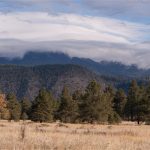2024 availability!
- Single- and multi-day meetings
- Affordable housing for visiting faculty, field classes, and workshops
Research sites and resources
The Merriam-Powell Research Station (MPRS) occupies a 5-acre parcel within The Arboretum of Flagstaff’s 200-acre holdings, which lie about 5 miles west of Flagstaff, Arizona. The MPRS draws researchers and students interested in the unique natural resources and ecological conditions of the southern Colorado Plateau. Some of the region’s resources include the following:
- The Arboretum of Flagstaff – The Arboretum was originally established as a research institute and has a long history of hosting and producing scientific work. For example, beginning in 1986, Northern Arizona University biology classes examined different pasture grass mixes on The Arboretum’s grounds, and subsequent investigations have ranged from investigating burning slash piles (2001) to examining mycorrhizal fungal techniques (2007). Habitats found on The Arboretum’s property include ponderosa pine forest, alpine meadow, ephemeral streams, a wetland, and a pond. The Arboretum’s pond is home to the federally threatened Little Colorado spinedace (Lepidomeda vittata), a fish only found in the Little Colorado River drainage. A constructed wetland system built in 1995 to help manage waste is a unique feature of The Arboretum. This system, which is still in use today and has produced some positive results, was designed to test the ability of native plant species to act as efficient biofilters. In addition to 80 acres protected from large herbivores, research resources include laboratory, greenhouse, and common garden space.
- Elevation Gradient – The elevation gradient along the San Francisco Peaks has been a key research resource since C. Hart Merriam made it famous more than 120 years ago. This elevation gradient encompasses climatic variations that define habitats ranging from desert to alpine forests. Using elevation gradients, researchers can predict how future changes in climate will alter species and ecosystems. For example, The University of Arizona’s Dr. David Breshears and his research group have focused on drought-induced tree mortality using the elevation gradient along the San Francisco Peaks.
- NAU Centennial Forest -The NAU Centennial Forest, which is managed by the School of Forestry, comprises approximately 47,000 acres of forest, woodland, and grassland, all located within a short distance of Flagstaff. Researchers have used a spectrum of land management treatments on Centennial Forest lands to examine the effects of management interventions on vegetation, greenhouse gas flux, and wildlife. In particular, Centennial Forest has been used to examine large-scale thinning and burning experiments on forested lands.
